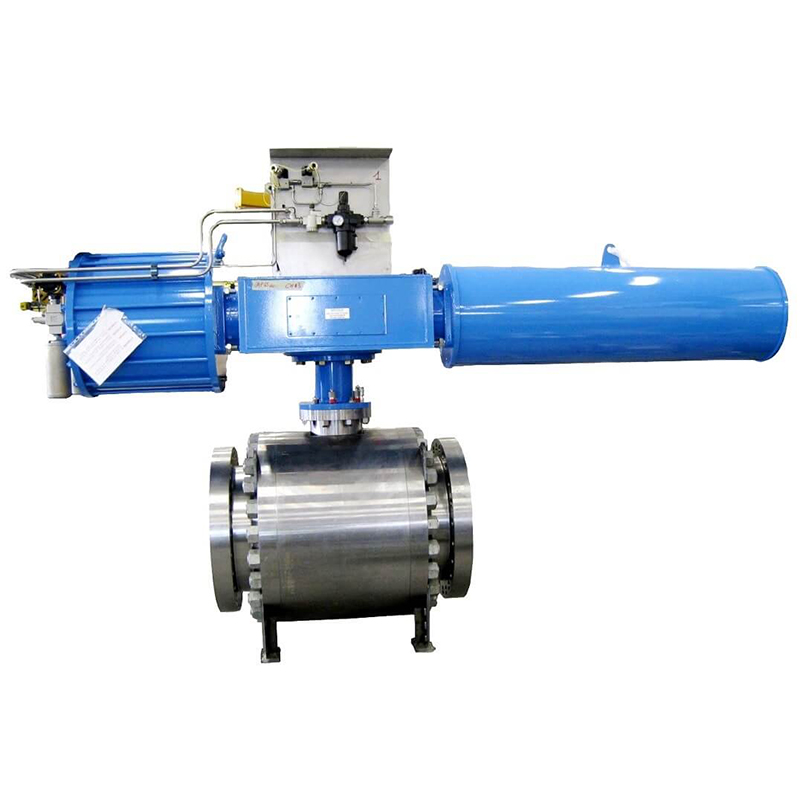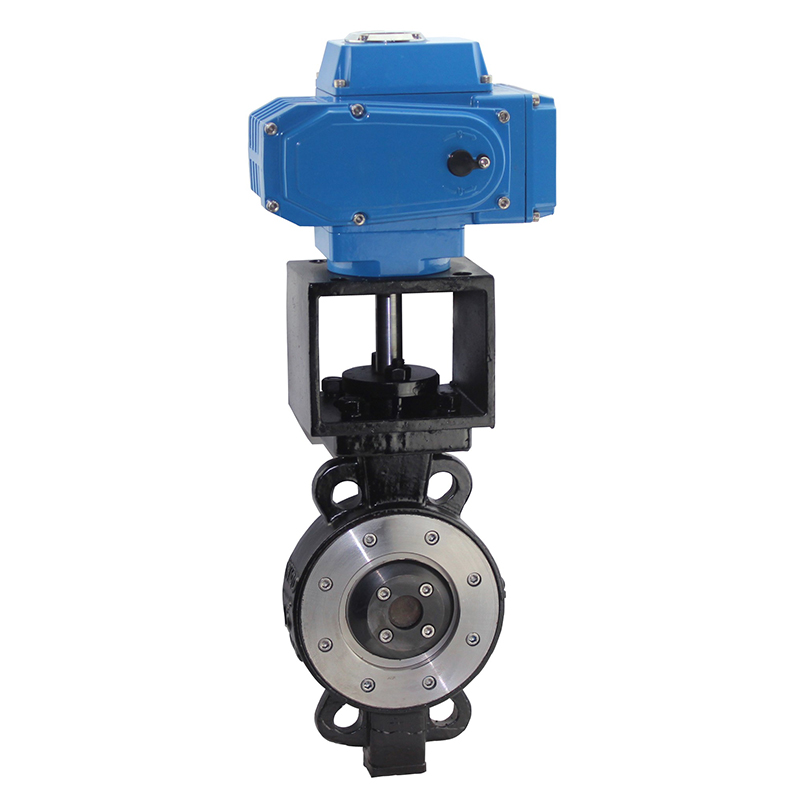
Products
SDV valve (Shut Down Valve)
✧ Description
The SDV valve (Shut Down Valve) is a valve with a V-shaped opening on one side of the half-ball spool. By adjusting the opening of the spool, the cross-sectional area of the medium flow is changed to adjust the flow. It can also be used for switch control to realize the opening or closing of the pipeline. It has a self-cleaning effect, can achieve small flow adjustment in the small opening range, adjustable ratio is large, suitable for fiber, fine particles, slurry media.
The opening and closing part of the V-type ball valve is a sphere with a circular channel, and the two hemispheres are connected by a bolt and rotate 90° to achieve the purpose of opening and closing.
It is widely used in the automatic control system of petroleum, chemical industry and so on.
✧ Parameters of Fully Welded Ball Valves Side Entry
| Product | SDV valve (Shut Down Valve) (V port) |
| Nominal diameter | NPS 2”, 3”, 4”, 6”, 8”, 10”, 12”, 14”, 16”, 20” |
| Nominal diameter | Class 150, 300, 600, 900, 1500, 2500. |
| End Connection | Flanged (RF, RTJ), BW, PE |
| Operation | Lever, Worm Gear, Bare Stem, Pneumatic Actuator, Electric Actuator |
| Materials | Casting: A216 WCB, A351 CF3, CF8, CF3M, CF8M, A352 LCB, LCC, LC2, A995 4A. 5A, Inconel, Hastelloy, Monel |
| Structure | Full or Reduced Bore, RF, RTJ, BW or PE, Side entry, top entry, or welded body design Double Block & Bleed (DBB),Double Isolation & Bleed (DIB) Emergency seat and stem injection Anti-Static Device |
| Design and Manufacturer | API 6D, API 608, ISO 17292 |
| Face to Face | API 6D, ASME B16.10 |
| End Connection | BW (ASME B16.25) |
| MSS SP-44 | |
| RF, RTJ (ASME B16.5, ASME B16.47) | |
| Test and Inspection | API 6D, API 598 |
| Other | NACE MR-0175, NACE MR-0103, ISO 15848 |
| Also available per | PT, UT, RT,MT. |
| Fire safe design | API 6FA, API 607 |
✧ Features of SDV valve (Shut Down Valve) (V port)

1. the fluid resistance is small, the flow coefficient is large, the adjustable ratio is high. It can reach :100:1, which is much larger than the adjustable ratio of straight single-seat regulating valve, two-seat regulating valve and sleeve regulating valve. Its flow characteristics are approximately equal percentage.

2. reliable sealing. The leakage grade of the metal hard seal structure is Class IV of GB/T4213 "Pneumatic Control Valve". The leak grade of the soft seal structure is Class V or Class VI of GB/T4213. For hard sealing structure, the ball core sealing surface can be made of hard chromium plating, surfacing cobalt based cemented carbide, spraying tungsten carbide wear-resistant coating, etc., to improve the service life of the valve core seal.
3. open and close quickly. V-type ball valve is an angular stroke valve, from fully open to fully closed spool Angle 90°, equipped with AT piston pneumatic actuator can be used for rapid cutting conditions. After installing the electric valve positioner, it can be adjusted according to the analog signal 4-20Ma ratio.

4. good blocking performance. The spool adopts 1/4 hemispherical shape with unilateral seat structure. When there are solid particles in the medium, the cavity blockage will not occur like ordinary O-type ball valves. There is no gap between the V-shaped ball and the seat, which has a large shear force, especially suitable for the control of suspension and solid particles containing fiber or small solid particles. In addition, there are V-shaped ball valves with global spool, which are more suitable for high pressure conditions and can effectively reduce the deformation of the ball core when the high pressure difference is made. It adopts single seat sealing or double seat sealing structure. The V-shaped ball valve with double seat seal is mostly used for clean medium flow regulation, and the medium with particles can cause the danger of clogging the middle cavity.

5. V-type ball valve is a fixed ball structure, the seat is loaded with spring, and it can move along the flow path. Can automatically compensate the spool wear, prolong the service life. The spring has hexagonal spring, wave spring, disc spring, cylindrical compression spring and so on. When the medium has small impurities, it is necessary to add sealing rings to the spring to protect it from impurities. For double seat sealed global spool V-ball valves, the floating ball structure is used.
6. when there are fire and anti-static requirements, the valve core is made of metal hard seal structure, the filler is made of flexible graphite and other high temperature resistant materials, and the valve stem has a sealing shoulder. Take electrostatic conduction measures between valve body, stem and sphere. Comply with GB/T26479 fire-resistant structure and GB/T12237 antistatic requirements.
7. V-shaped ball valve according to the different sealing structure of the ball core, there are zero eccentric structure, single eccentric structure, double eccentric structure, three eccentric structure. The commonly used structure is zero eccentric. The eccentric structure can quickly release the spool from the seat when it is opened, reduce the wear of the seal ring and extend the service life. When closed, a eccentric force can be generated to enhance the sealing effect.

8. The driving mode of V-type ball valve has handle type, worm gear transmission, pneumatic, electric, hydraulic, electro-hydraulic linkage and other driving modes.

9.V-type ball valve connection has flange connection and clamp connection two ways, for the global spool, double seat sealing structure and thread connection and socket welding, butt welding and other connection methods.
10.ceramic ball valve also has V-shaped ball core structure. Good wear resistance, but also acid and alkali corrosion resistance, more suitable for the control of granular media. The fluorine lined ball valve also has a V-shaped ball core structure, which is used for regulating and controlling acid and alkali corrosive media. The application range of V-type ball valve is more and more extensive.
✧ After-Sale Service
The after-sales service of the SDV valve (Shut Down Valve) (V port) is very important, because only timely and effective after-sales service can ensure its long-term and stable operation. The following are the after-sales service contents of some floating ball valves:
1.Installation and commissioning: After-sales service personnel will go to the site to install and debug the floating ball valve to ensure its stable and normal operation.
2.Maintenance: Regularly maintain the floating ball valve to ensure that it is in the best working condition and reduce the failure rate.
3.Troubleshooting: If the floating ball valve fails, the after-sales service personnel will carry out on-site troubleshooting in the shortest possible time to ensure its normal operation.
4.Product update and upgrade: In response to new materials and new technologies emerging in the market, after-sales service personnel will promptly recommend update and upgrade solutions to customers to provide them with better valve products.
5. Knowledge training: After-sales service personnel will provide valve knowledge training to users to improve the management and maintenance level of users using floating ball valves. In short, the after-sales service of the floating ball valve should be guaranteed in all directions. Only in this way can it bring users a better experience and purchase safety.










